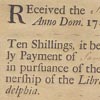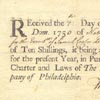
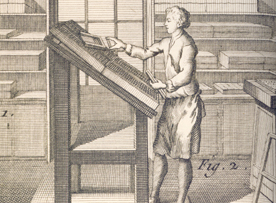
"L'Operation de la Casse" [detail], engraving in Denis Diderot et al., Encylopedie, ou, Dictionnaire Raisonne des Sciences, des Arts et des Metiers, Paris, 1761-1789.
Section 3: Job Printing
By far the largest part of Franklin’s business was his newspaper, his almanacs, and government printing; but the next largest source of income was what today we call job printing, that is occasional printing work for hire, where the customer paid for the whole edition and distributed it how he pleased. This case is devoted to three kinds of job printing Franklin did: First, what he called “little Jobs,” that is blank forms, lottery tickets, hand bills and other ephemera. Second, paper money, which was a type of government printing, but we consider it here both because it was occasional and commissioned separately from his appointment as printer to the Assembly and because it physically resembles blank forms and lottery tickets. And third, what he called “book work,” where an author or a corporate body commissioned the printing of a book or pamphlet.
We [Franklin and his partner Meredith] scarce opened our Letters and put our Press in Order, before George House, an Acquaintance of Mine, brought a Countryman to us; whom he had met in the Street enquiring for a Printer. All our Cash was now expended in the Variety of Particulars we had been obliged to procure, and this Countryman’s Five Shillings, being our First Fruits and coming so seasonably, gave me more Pleasure than any Crown [five shillings] I have since earn’d.
Benjamin Franklin, Autobiography
“Little Jobs”
“Little jobs” were always welcome to Franklin as a source of ready money. The very first thing printed by Franklin and Meredith when they set up in business in 1728 was some kind of broadside advertisement. Franklin always put aside other work, even when it was pressing, to accommodate these jobs. When he was printing Sewel’s History of the Quakers in 1728, “It was often 11 at Night and sometimes later, before I had finished my Distribution [of type] for the next day’s Work: For the little Jobs sent in by our other Friends now and then put us back.”
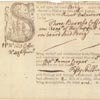 Bill of Lading, Shipped in good Order and well-conditioned [Philadelphia: B. Franklin, 1740-1768].
Bill of Lading, Shipped in good Order and well-conditioned [Philadelphia: B. Franklin, 1740-1768].
Franklin specialized in printing blank legal forms "of all Sorts the correctest that ever appear'd among us"; for example, bills of lading, by which a ship captain acknowledged freight consigned to him.
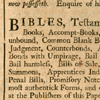 All the Blanks in the most authentick Forms, and correctly printed; may be had at the Publlishers of this Paper, Pennsylvania Gazette (Philadelphia: Printed by B. Franklin and H. Meredith, October 2, 1729).
All the Blanks in the most authentick Forms, and correctly printed; may be had at the Publlishers of this Paper, Pennsylvania Gazette (Philadelphia: Printed by B. Franklin and H. Meredith, October 2, 1729).
Printed forms were sure to have the precise legal wording and punctuation, and they were cheaper and more convenient than employing a scrivener to write them by hand.
Library Company of Philadelphia, subscription receipts and meeting notice [Philadelphia: B. Franklin, 1730s and 1740s].
The archives of the Library Company preserve many of the small jobs that Franklin printed for just one of his numerous institutional customers.
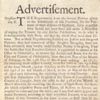 Pennsylvania Proprietaries, Advertisement [Philadelphia: B. Franklin, December 24, 1735].
Pennsylvania Proprietaries, Advertisement [Philadelphia: B. Franklin, December 24, 1735].
Franklin had a standard form for advertisements like this, headed simply “Advertisement.”
 Advertisements, Pennsylvania Gazette (Philadelphia: B. Franklin, December 24, 1735).
Advertisements, Pennsylvania Gazette (Philadelphia: B. Franklin, December 24, 1735).
Some advertisers placed an ad in the Gazette and also had a handbill or broadside printed separately.
Paper Money
The most lucrative “little job” of all was printing paper money, and from 1730 on Franklin was the printer of all the money issued by Pennsylvania, New Jersey, and Delaware. He may have made as much from printing money as from printing the Votes and Laws for the colonial assemblies. Paper money was first introduced in the region in 1723, but it remained a divisive political issue because it helped farmers and tradesmen, but merchants and landowners wanted either to eliminate it or limit its circulation.
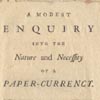 [Benjamin Franklin], A Modest Inquiry into the Nature and Necessity of a Paper Currency (Philadelphia: Printed and sold at the New Printing Office, 1729).
[Benjamin Franklin], A Modest Inquiry into the Nature and Necessity of a Paper Currency (Philadelphia: Printed and sold at the New Printing Office, 1729).
In this pamphlet, the first one he wrote in Philadelphia, Franklin argued for a bill increasing the paper money supply. The bill was approved. Franklin’s friends in the Assembly tried to get him the job of printing the money, but that prize went to Bradford. Franklin’s reward was the much smaller job of printing blank forms associated with the currency emission. The next time, though, he got the money job too.
 Twenty Shilling Note, To Counterfeit is Death. (Philadelphia: Printed by Franklin and Hall, 1759).
Twenty Shilling Note, To Counterfeit is Death. (Philadelphia: Printed by Franklin and Hall, 1759).
Paper money printed from ordinary type was easy to counterfeit, but Franklin ingeniously solved that problem by printing pictures of leaves on every piece of money. Counterfeiters could not duplicate or even imitate the fine lines and irregular patterns. The process by which he made the printing plates was secret, but they probably were cast in type metal from molds made by pressing leaves into plaster of Paris.
Courtesy Eric P. Newman Numismatic Education Society.
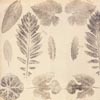 Joseph Breintnall and Benjamin Franklin, Nature Prints of Leaves [Philadelphia, ca. 1740].
Joseph Breintnall and Benjamin Franklin, Nature Prints of Leaves [Philadelphia, ca. 1740].
Franklin probably got the idea of printing images of leaves on paper money from making these nature prints, which he and Breintnall sent to English naturalists. They were printed directly from inked leaves, which were placed inside a folded sheet of paper and run through the press.
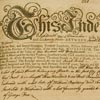 Pennsylvania General Loan Office Register [Philadelphia: B. Franklin, 1729]. From the collection of Jay T. Snider.
Pennsylvania General Loan Office Register [Philadelphia: B. Franklin, 1729]. From the collection of Jay T. Snider.
This volume of blank mortgage forms was Franklin’s first government printing job. It is the official record of the mortgages that backed the currency emission of 1729, £30,000 worth. People mortgaged their land in return for currency, which went into circulation as they spent it, and when they repaid the loan with interest, the currency was retired. The volume, which is in a private collection, was only discovered in the 1990s.
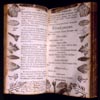 Michael Pexenfelder, Apparatus Eruditionis tam Rerum quam Verborum per Omnes Artes et Scientias (Nuremberg: Sumptibus Michaelis & Joh. Friderici Endterorum, 1670).
Michael Pexenfelder, Apparatus Eruditionis tam Rerum quam Verborum per Omnes Artes et Scientias (Nuremberg: Sumptibus Michaelis & Joh. Friderici Endterorum, 1670).
The earliest surviving American nature prints were made in this little German encyclopedia by Francis Daniel Pastorius, the founder of Germantown, sometime before 1720. The book was later bought by James Logan, who probably showed it to Franklin and Breintnall.
 Undivided sheet of Continental Currency, printed on blue paper for use as a counterfeit detector (Philadelphia: Printed by Hall and Sellers, 1776)
Undivided sheet of Continental Currency, printed on blue paper for use as a counterfeit detector (Philadelphia: Printed by Hall and Sellers, 1776)
Franklin’s leaf cuts were used on money right up through the Revolution.
Book Work
Another kind of job printing was “book work,” that is books and pamphlets printed at the expense of their authors or sponsors. Today, this is called vanity publishing, but in the colonial period it was how most books were published. Most of the books commissioned in this way were pamphlets, usually under a hundred pages, issued stitched but not bound. Only rarely did an author or a corporate body hire Franklin to print anything larger, or go to the even greater expense of having it bound in leather. From 1728 to 1747, book work accounted for 110 imprints, of which only 16 were issued bound in leather. Franklin was by far the largest printer outside Boston, but books still accounted for only a small part of his business.
 United Brethren, Avthentische Relation von dem Anlass, Fortgang und Schlusse der … in Germantown gehaltenen Versammlung. (Philadelphia: B. Franklin, 1742). On deposit from the archives of the Eastern Conference of the United Methodist Church.
United Brethren, Avthentische Relation von dem Anlass, Fortgang und Schlusse der … in Germantown gehaltenen Versammlung. (Philadelphia: B. Franklin, 1742). On deposit from the archives of the Eastern Conference of the United Methodist Church.
Here are nine pamphlets printed at the expense of the Moravian Count von Zinzenndorf, as issued, stitched and never bound.
 Alexander Arscott, Some Considerations relating to the Present State of the Christian Religion (Philadelphia: B. Franklin, 1731).
Alexander Arscott, Some Considerations relating to the Present State of the Christian Religion (Philadelphia: B. Franklin, 1731).
This book printed for the Friends was issued stitched even though it was 112 pages, much larger than the usual pamphlet.
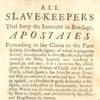 Benjamin Lay, All Slave-Keepers that keep the Innocent in Bondage, Apostates. (Philadelphia: Printed [by B. Franklin] for the Author, 1737).
Benjamin Lay, All Slave-Keepers that keep the Innocent in Bondage, Apostates. (Philadelphia: Printed [by B. Franklin] for the Author, 1737).
Franklin printed this attack on slaveholding for its author. Because he did not want his name associated with the controversial anti-slavery activist, he printed it anonymously, one of the few times he did so.
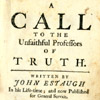 John Estaugh, A Call to the Unfaithful Professors of Truth. (Philadelphia: Printed by B. Franklin, 1744).
John Estaugh, A Call to the Unfaithful Professors of Truth. (Philadelphia: Printed by B. Franklin, 1744).
Franklin printed 2,000 copies of this book for the author’s widow, who gave them away to various local Meetings. This copy was neatly bound by Franklin’s favorite binder, Stephen Potts.


